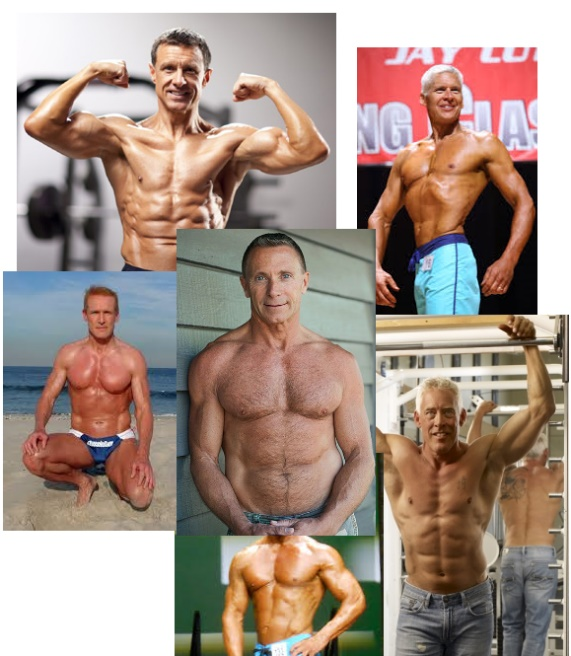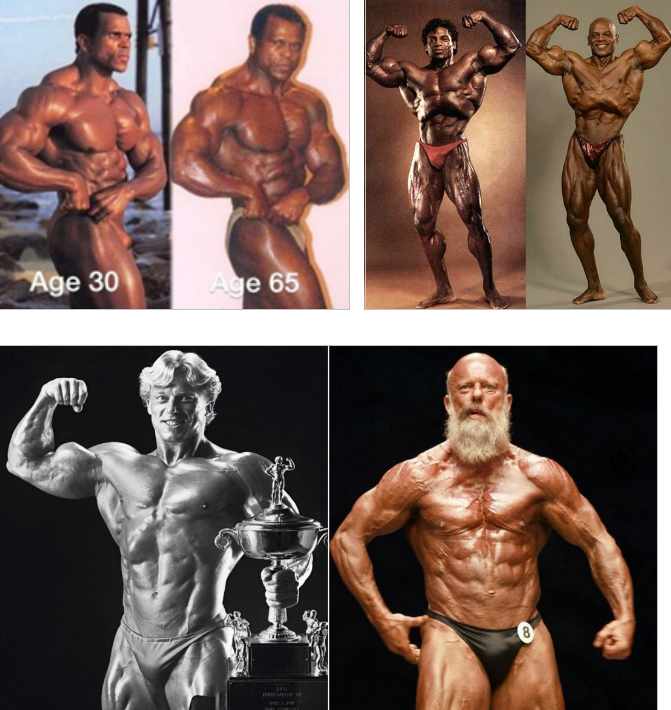
What can you really expect from the gym when you are over 50 years of age and you start lifting weights or working out? This article is focused on 50+ year old males who are thinking of getting back into a regular training routine. A future article will focus on the key challenges 50+ year old females face when they want to get into shape.
Many 50+-year-olds still feel like they are in their 30s and so therefore think that their bodies will respond just as quickly as when they actually were in their 30’s – unfortunately this is not the case.
This slowing rate of adaptation is because of several reasons, including:
- Your hormonal levels (Muscle building hormones – Testosterone/Growth Hormone) are going to be nowhere near what they were when you were younger.
- Your rate of recovery from any training bout is going to be much longer (due in part to 1.).
Your recovery time from exercise is going to be two or three times longer than when you were younger, and chance of injury is going to increase due to a decrease in the elasticity within your tendons and ligaments (making them effectively more “Fragile” to load/speed/power movements).
With 50+ individuals beginning to undertake a weights program, adaptation is much slower than what people expect resulting in the loss of motivation because of the lack of rate of improvement.
Also, any injuries you sustained in your teens, 20’s, 30’s or 40’s (depending on the extent of the injury) will be a point of limitation that if not managed carefully will put a halt to your training progress.
For example, I badly injured an adductor at the pelvic attachment region in my 20’s that is still a point of weakness today (in my 50’s) that stops me from completing certain types of lifts (eg squats) and reduces how hard I can push other leg strengthening exercises (eg leg press, hack squat, etc).
What is quite misleading is seeing regular images of fit 50+ year olds that are in super shape and often with 6-packs.
Not wanting to lower your expectations (and associated excitement) of joining a gym with aspirations of looking like one of these models but it is important to understand the background of most if not all these models to better put into perspective your potential progress once you are regularly working out.
50+ YEAR OLD FITNESS MODELS

50+ year old male fitness models will have typically been in shape for decades before their 50’s and so they can still look in great shape with plenty of muscle and be super lean even if they are only a fraction of their physical shape when in their 20’s & 30’s.
Whilst it is great to aspire to these body types, the road to this sort of body shape is going to be very difficult (if you don’t have this training and physique background) and a more modest body shape goal should be prioritised to ensure you keep motivated during the months (and years) you will need to train to achieve your desired shape.

You often see these extreme examples of musculature and leanness in individuals over 50 that are used to convince people to buy new training equipment or start taking a new supplement, etc.
Unless you were a bodybuilder or in great muscular shape in your 20’s or 30’s, it is not possible to look like these 50+ year old body building fitness models because they were all in amazing shape when young (many were international bodybuilder competitors) and they have been able to maintained some of their prior muscle mass (and kept lean) into their 50’s and 60’s.
It is a very different proposition to try to put on this sort of size/shape without having the training/physical background in the first place.
In my opinion, what we should all be aspiring for is a focus on leanness over mass. Getting lean will make you look better even if you are in only average muscular shape.
Back to the focus of this article – that of getting into great shape when 50+.
Hormonal Levels and older age: I covered this article last week “Hormonal Levels & Aging” so please review this blog article to gain a better understanding of how reduced anabolic hormones (testosterone and human growth hormone) will effect your muscle building goals.
Training & Rate of recovery: Rate of recovery from exercise is dependent upon several factors:
- Your hormonal levels (as discussed in a previous article).
- Your training back ground (have you regularly trained).
- What recovery methodologies if any that you use (Sleep, massage, nutrition).
- What exercise you actually do (Aerobic, Anaerobic, Strength, Power).
What I have found difficult to accept (based on my training background as a young athlete) is that I am unable to recover from training as quickly as I once did, and more importantly recover from any injury that I might sustain during training like I once used to be able to.
Even thought I was a regular trainer from my teens right into my 40’s – I have still seen a marked reduction in my recovery abilities from heavy & regular strength training as I moved into my 50’s.
If you haven’t this sort of training background, then whilst you won’t have anything to compare to – it is always good to not jump into a full blown training routine (such as a New Year’s Resolution type exercise routine) because there is a high chance that you won’t be able to maintain such a routine both through physical and psychological fatigue.
What is difficult to come to terms with is that getting into shape takes a long time and even more so when you are in your 40’s, 50’s or older. It is vital that you carefully plan your training loads, ensure you have plenty of rest (see section on Periodization below) and that you try to regulate your enthusiasm for the long game.
This significant decrease in recovery time after training should not be ignored and it will have a major influence on how you train and more importantly how you recover b/w training sessions.
Back in the day (in my teens and 20’s) I could back up twice a day most days of the week with a combination of strength, endurance and technical training – Now that I am in 50’s I find that I am unable to undertake more than 1 hard session per day and I must alternate hard days with easy days otherwise I find myself very quickly over-training and not recovering b/w sessions resulting in an increased chance of getting injured.
Whilst getting into shape can be a reasonable short-term goal, the longer-term goal should be to get into a routine that you can continue well into your 60’s and beyond.
It is not a coincidence that regular strength training is being hailed as the “Fountain of Youth” by sports scientists and doctors worldwide.
The challenge is ensuring you have the right training (periodized) plan for you that provides adequate adaptation with recovery intervals to allow your body to fully adapt to the training that you undertake.
So what is this term Periodization? This term was coined in the 1960’s when dealing with Olympic athletes and how their training program was varied day to day, week to week to continue adaptation and reduce any stagnation/injury. We can use the basics of this training principle to ensure that we minimise overtraining or the development of overuse injuries.
PERIODIZATION

Periodization is the approach of varying your total training load over time – this has several benefits:
- The body likes to adapt to what you are doing so if you don’t mix it up the body will have no reason to change/improve over time.
- Mentally it is very good to change up what you do on a regular basis.
- Most importantly, periodization allows you to fit in recovery periods b/w your training periods which is vital as you age to ensure that you don’t over train and get injured.
Most athletic periodised cycles are anywhere from 4-8 weeks (eg 4-8 weeks of training to one week of recovery).
I have been training in the gym seriously for 6 years and I work on a 3-week cycle (2-weeks hard, 1 week easy). This might seem conservative, but I know that during these two weeks I can push myself very hard with the knowledge that I will have an easier week in week 3 & historically, every time I tried to train beyond a 2-week training period, I would get injured putting me back several months.
My recovery week isn’t a rest – in fact, I increase my interval training sessions and do more circuit style training (I train just as many days as my hard weeks but less overall weight/load intensity).
If you have trained hard during your heavy weeks, you will be amazed at how much you look forward to your recovery week.
I work out at a University Gym – surrounded by 18-25 year old’s – many train very hard but don’t understand the concept of periodization and over the years I have seen many of these students train for weeks on end – no easy/recovery week – until they injure themselves (A force down period), only to get back into training and slowly overtrain until they again get injured resulting in them never achieving their training goals and through recurrent injury giving the whole exercise activity away.
In fact, one young guy who is very strong (200kg squat) got injured and when I queried him about his periodization model, he didn’t have one – he just lifted the same or more each week so no wonder he got injured.
I convinced him to start having 1 week rest every 8-weeks and in a little over a year he is now resting every 3-4 weeks because of the benefits he is seeing from having a regular down week. Just recently he had a significant squat personal best as his body is now more rested, adapting better and he is psychologically more prepared for heavy lifting than he was before when grinding week after week.
So regardless of your training background, it is vital to include a lighter loading week on a regular basis to ensure that you stay injury free, give your body time to recover from your hard training weeks and keeping psychologically fresh which is important to get the most out of your strength training routines.
SUMMARY
- Don’t expect rapid changes in body shape when you start in the gym.
- Try to take the long view of why you are in the gym (not just getting into shape for summer but to try to incorporate this activity into your normal weekly routine so that it can be sustainable for years).
- Expect recovery times b/w sessions to be much longer than you remember when younger.


